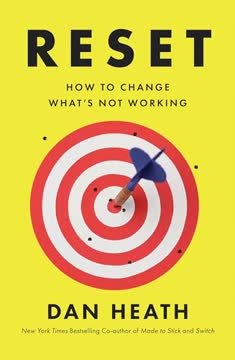Key Takeaways
1. Upstream thinking prevents problems before they occur
When you spend years responding to problems, you can sometimes overlook the fact that you could be preventing them.
Reactive vs. proactive approaches. Upstream thinking focuses on preventing problems rather than reacting to them after they occur. This approach can be applied in various domains, from healthcare to education to business.
Examples of upstream interventions:
- Expedia reducing customer support calls by 43 percentage points
- Chicago Public Schools increasing graduation rates by 25 percentage points
- Iceland dramatically reducing teenage substance abuse
Benefits of upstream thinking:
- Cost-effective in the long run
- Improves quality of life
- Addresses root causes rather than symptoms
2. Problem blindness hinders proactive problem-solving
The seed of improvement is dissatisfaction.
Recognizing hidden issues. Problem blindness occurs when we accept negative outcomes as natural or inevitable, preventing us from taking action to solve them.
Causes of problem blindness:
- Normalization of abnormal situations
- Lack of awareness or exposure
- Complacency or resignation
Overcoming problem blindness:
- Questioning the status quo
- Seeking diverse perspectives
- Collecting and analyzing data to reveal hidden patterns
3. Taking ownership is crucial for effective upstream work
I was not the one who created this problem. But I will be the one to fix it.
Embracing responsibility. Taking ownership of a problem, even if you didn't create it, is essential for driving change and implementing solutions.
Key aspects of taking ownership:
- Recognizing your capacity to make a difference
- Overcoming the bystander effect
- Mobilizing resources and support
Examples of ownership in action:
- Ray Anderson transforming Interface's environmental impact
- Dr. Bob Sanders advocating for child car seat laws
- Tricia Dyal creating Daddy Dolls for military families
4. Tunneling narrows focus and impedes preventive action
Tunneling begets more tunneling.
Breaking free from short-term thinking. Tunneling occurs when scarcity of resources or time forces people to focus solely on immediate concerns, neglecting long-term solutions.
Effects of tunneling:
- Prioritizing urgent tasks over important ones
- Difficulty in strategic planning
- Perpetuating cycles of crisis management
Strategies to combat tunneling:
- Creating "slack" in systems
- Implementing structured time for long-term thinking
- Fostering a culture that values prevention
5. Uniting the right people is essential for tackling complex issues
Each one of them gets a role.
Collaborative problem-solving. Complex problems require diverse perspectives and expertise to solve effectively.
Key elements of successful collaboration:
- Identifying stakeholders with relevant knowledge and resources
- Establishing clear roles and responsibilities
- Fostering open communication and trust
Case studies in effective collaboration:
- Iceland's approach to reducing teenage substance abuse
- Domestic Violence High Risk Team in Newburyport, Massachusetts
- Rockford, Illinois, ending veteran homelessness
6. Systemic change requires identifying leverage points
Macro starts with micro.
Finding strategic intervention points. Identifying key leverage points within complex systems can lead to significant, widespread changes with minimal effort.
Characteristics of effective leverage points:
- High impact potential
- Feasibility of implementation
- Ripple effects throughout the system
Examples of leverage points:
- Freshman On-Track metric in Chicago Public Schools
- Contraflow traffic management for hurricane evacuations
- Cognitive behavioral therapy in reducing youth violence
7. Early warning systems enable timely interventions
When we can foresee a problem, we have more maneuvering room to fix it.
Anticipating and preventing issues. Early warning systems allow for proactive interventions before problems escalate.
Components of effective early warning systems:
- Data collection and analysis
- Clear indicators and thresholds
- Rapid response protocols
Examples of early warning systems:
- LinkedIn's customer churn prediction
- Japan's earthquake detection system
- Sandy Hook Promise's anonymous reporting system for school safety
8. Measuring success in upstream efforts is challenging but vital
We can't surge forward with certainty into a world of no surprises, but we can expect surprises and learn from them and even profit from them.
Evaluating preventive impact. Measuring the success of upstream efforts can be difficult, as success often means the absence of problems.
Challenges in measuring upstream success:
- Proving causation for prevented events
- Long time horizons for results
- Difficulty in quantifying non-events
Strategies for effective measurement:
- Using proxy indicators and leading metrics
- Implementing controlled trials when possible
- Combining quantitative and qualitative data
9. Unintended consequences demand careful consideration
Systems can't be controlled, but they can be designed and redesigned.
Anticipating ripple effects. Upstream interventions can have unintended consequences that may undermine their intended benefits.
Approaches to managing unintended consequences:
- Systems thinking and modeling
- Pilot testing and gradual implementation
- Continuous monitoring and adaptation
Examples of unintended consequences:
- Macquarie Island's ecological interventions
- Open-office plans reducing face-to-face interactions
- Plastic bag bans leading to increased use of thicker plastic bags
10. Far upstream thinking addresses unprecedented challenges
We have just been lucky.
Preparing for the unknown. Far upstream thinking involves anticipating and preparing for unprecedented challenges that could have catastrophic consequences.
Characteristics of far upstream challenges:
- Low probability but high impact
- Lack of historical precedent
- Potential for global or existential consequences
Approaches to far upstream thinking:
- Scenario planning and red teaming
- Investing in research and development
- Fostering international cooperation and governance
Examples of far upstream challenges:
- Artificial intelligence safety
- Biosecurity and pandemic prevention
- Asteroid impact mitigation
Last updated:
FAQ
What's Upstream: The Quest to Solve Problems Before They Happen about?
- Focus on Prevention: The book emphasizes the importance of upstream thinking, which involves preventing problems before they occur rather than reacting to them after the fact.
- Real-World Examples: Dan Heath uses case studies, such as Expedia's customer service overhaul and Iceland's campaign against teenage substance abuse, to illustrate upstream thinking.
- Systemic Change: It argues for changing the systems that create problems, rather than just treating symptoms, to effectively address societal issues.
Why should I read Upstream by Dan Heath?
- Actionable Insights: The book provides practical strategies for individuals, organizations, and communities to adopt upstream thinking in their own lives and work.
- Broad Applicability: Concepts discussed are relevant across various fields, including healthcare, education, and public policy, making it valuable for professionals in multiple sectors.
- Inspiring Change: Heath's narrative motivates readers to shift focus from reactive measures to proactive solutions that can lead to lasting change.
What are the key takeaways of Upstream?
- Shift to Upstream Thinking: Advocates for a cultural shift towards preventing problems rather than just responding to them, requiring a change in mindset and organizational structure.
- Collaboration is Crucial: Successful upstream efforts often involve collaboration among various stakeholders, uniting the right people around a common goal.
- Data-Driven Decisions: Emphasizes using data to identify problems early and measure success, allowing for informed decision-making and strategy adaptation.
What are the best quotes from Upstream and what do they mean?
- “Every system is perfectly designed to get the results it gets.” Highlights that outcomes reflect system structure, and changing results requires changing the system.
- “We’re capable of greater things: less Undo and more Outdo.” Encourages focusing on proactive solutions rather than fixing problems after they arise.
- “You can’t solve a problem that you can’t see.” Stresses the importance of awareness in addressing issues, as recognizing problems is the first step toward solutions.
What is upstream thinking as defined in Upstream?
- Preventive Approach: Upstream thinking involves efforts to prevent problems before they happen or reduce harm systematically.
- Systems Thinking: Involves understanding interconnected factors contributing to problems, aiming to address root causes for sustainable solutions.
- Examples of Upstream Actions: Includes teaching children to swim to prevent drownings or community programs to reduce substance abuse.
How does Upstream illustrate the concept of problem blindness?
- Definition of Problem Blindness: Described as the belief that negative outcomes are natural or inevitable, leading to passivity in addressing them.
- Case Studies: Uses examples like Chicago Public Schools' graduation rates to show how stakeholders accepted poor outcomes as unchangeable.
- Overcoming Blindness: Suggests fostering a culture of inquiry and encouraging stakeholders to question the status quo to identify and address issues.
What role does collaboration play in upstream efforts according to Upstream?
- Essential for Success: Collaboration among diverse stakeholders is crucial for effective upstream interventions, as no single entity can address complex problems alone.
- Examples of Collaboration: Highlights successful examples like Iceland's campaign against teenage substance abuse and the Domestic Violence High Risk Team.
- Shared Goals: Establishing a common aim helps align efforts, making it easier to coordinate actions and measure progress for lasting change.
How can I identify leverage points for upstream interventions as suggested in Upstream?
- Understanding Risk and Protective Factors: Analyzing these factors can help identify potential leverage points for intervention.
- Targeting Vulnerable Populations: Focusing on specific subpopulations that contribute disproportionately to a problem can be effective.
- Data-Driven Insights: Utilizing data to understand patterns and trends can reveal leverage points not immediately obvious.
What are some examples of successful upstream interventions mentioned in Upstream?
- Expedia's Customer Service Overhaul: Reduced call volume by addressing root causes of inquiries, improving customer experience and reducing costs.
- Iceland's Anti-Substance Abuse Campaign: Changed culture around teenage drinking, reducing substance abuse rates through collaboration.
- Domestic Violence High Risk Team: Prevented domestic violence homicides by uniting agencies and using data to identify high-risk cases.
How does Upstream address the challenges of measuring success in upstream efforts?
- Complexity of Success Metrics: Highlights that measuring success can be challenging due to the long-term nature of upstream goals.
- Risk of Ghost Victories: Warns against superficial successes masking underlying failures, emphasizing alignment of short-term measures with long-term objectives.
- Data for Learning: Emphasizes using data to track progress and inform decision-making, focusing on meaningful metrics reflecting true impact.
How does Upstream suggest measuring success?
- Quality Over Quantity: Emphasizes using metrics that reflect quality of outcomes rather than just numerical targets.
- Feedback Loops: Advocates for continuous feedback mechanisms for real-time adjustments and improvements in programs.
- Balanced Metrics: Introduces “paired measures” using both quantitative and qualitative metrics to assess success comprehensively.
How can individuals apply the concepts from Upstream in their own lives?
- Identify Personal Problems: Encourages reflection on recurring issues and considering proactive solutions.
- Engage with Community: Suggests collaborating with others in the community to tackle shared challenges through volunteering or local initiatives.
- Embrace a Growth Mindset: Encourages continuous learning and improvement, being open to experimenting with new ideas and adapting approaches.
Review Summary
Upstream receives mostly positive reviews for its insights on proactive problem-solving and prevention. Readers appreciate the real-world examples and thought-provoking ideas, though some find it repetitive. The book's core message of addressing root causes rather than symptoms resonates with many. Reviewers praise Heath's writing style and the book's accessibility. Some criticize the lack of detailed implementation guidance. Overall, readers find the book valuable for reframing approaches to problem-solving in various fields, from business to personal life.
Similar Books










Download PDF
Download EPUB
.epub digital book format is ideal for reading ebooks on phones, tablets, and e-readers.






